Paul Kean of The Bats demonstrates the sound of a Jansen Teardrop guitar, when played through a Concord Allegro 351 amplifier.
Ironically the success of Bennie Gunn’s Concord amplifiers was due to a genre of music for which he had no time. “It was the rock’n’roll era that kicked it off,” he told Chris Bourke in 2009. “I am more a jazz musician than rock’n’roll, but I was manufacturing before then with PA systems. It seemed quite natural to get into guitar amplifiers. I was previously doing PA systems and intercoms. I had been working as a technician and recording engineer for Broadcasting [NZBS], in Wellington.”
In 1957, after playing piano in jazz trios and big bands in Wellington, Gunn moved to Auckland, “not to start a business but as a musician. But it was not enough to earn a living. It was precarious in those days, and those people who were in fact musicians all had jobs.”
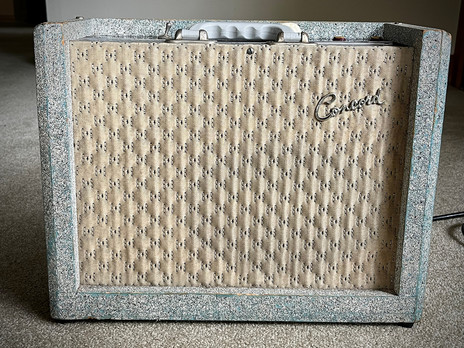
Paul Kean's Concord amp
Gunn was living in a musicians’ hangout at 57A Symonds Street in central Auckland. Most were close to broke, down to the last fiver between them. In the late 1950s Gunn decided there was space in the basement for a conveyor belt for his amplifier manufacturing. As well as amps, the firm would design several six-string guitars, a four-string electric bass, and an electric organ. “Guitars became a regular thing. Jansen was the main opposition – originally, they were my distributor. They thought they’d set up on their own and carried on in opposition.”

Concord prototype: a striking design by Concord from the early 1960s. This six-string guitar was in design stages when Concord moved out of guitar production. - Gordon Spittle Collection
The business moved to a two-storey house in Ellerslie, with a small factory at the back. Exports to Australia were another learning curve, with foreign currency purchases limited to a few pounds a day. “During that period I had to do all sorts of things to get the parts. You couldn’t take money out of New Zealand at that stage, so I took an amplifier, got a large amount of cash, and then hid it inside the amplifier to get funds into Australia.” Space was added to the circuit board for an extra valve. “That was only temporary, of course.”
After six years, the manufacturing out-grew the Ellerslie workshop, and the business moved to Northcote, on the North Shore. “We built a three-storey factory there, which made a big difference.”
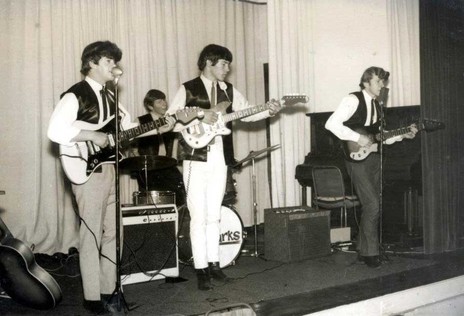
The Zarks, Auckland YWCA, Queen St, 1966. The amps are, from left, a Concord Cloud 7 (purchased from Farmers) and a Concord Contina. The musicians are, from left: Larry Killip, Greg Sharples, Denis "Tub" Winters, Terry Bradley.Larry Killip, Denis "Tub" Winters, Greg Sharples and Terry Bradley. - Larry Killip Collection
The business thrived, selling 1000 amplifiers a year at its peak. The production line provided some job experience for future big shakers in music and IT. “A number of technicians I trained went on to start their own businesses.” Among them were Glyn Tucker, who later started Mandrill recording studio, and Navman founder Sir Peter Maire. As amplifier production reached its peak, guitarist Peter Posa was recruited to market Concord as part of the Pacific sound. Posa praised its “clean sound – undistorted and pure”. The Quin Tikis showband played Super Chief amps and welcomed their power and reverb as closer to overseas standards.
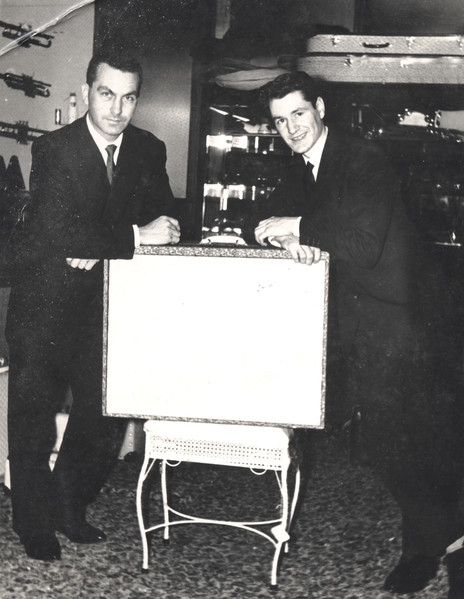
Guitar legends Johnny Bradfield and Peter Posa endorse Concord amplifiers, 1960s - Bennie Gunn Collection
Gunn’s business impressed the Roland company of Japan enough to become its agent in Australia and New Zealand. In the mid-60s, with the removal of government import controls, Roland made a successful takeover offer for the Concord brand; part of the attraction was the 90-plus dealers around New Zealand that Concord had relationships with to handle sales and guaranteed repairs. Within a few years, amplifiers were being imported from the US, England, and China. “There was absolutely no point making amplifiers locally anymore.” In the 1960s and 70s, however, there were several other New Zealand amplifer manufacturers, whose stories are told at AudioCulture’s New Zealand-made Guitar Amps page.The amplifier firm called Gunn had nothing to do with Bennie Gunn. It was founded in 1972 by guitarist Gray Bartlett and his brother Barry. After about a decade working from a factory in Papatoetoe, Gunn stopped production.
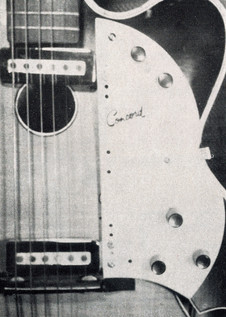
The Perspex scratchboard made by Concord clipped between the bridge and guitar neck and could amplify most round hole or f-hole acoustic guitars. The model ZE-1 provided one or two pickups, with rotary knobs to adjust treble and bass tones.
Bennie Gunn had already moved on: “We diversified into mainly PAs and intercoms, and then into domestic stereos and hi-fi.” By 1965 Concord had stopped manufacture of guitars and amplifiers to concentrate on new technologies of the time: communications, marine electronics, depth sounders. Gunn worked for Roland into the 1980s.
Of the Concord amps, Gunn says the most popular model was the Contina. “It was a small one, but in those days you didn’t need high power to be heard,” Gunn told AudioCulture in 2025. “We made big ones as well, mainly for visiting artists to cart around the country. One of those turned up recently, it was found by my eldest son. It’s been stuffed around, so he’s going to restore it to the original. Already young Max [Gunn’s grandson, musician Max Gunn] has borrowed it to take it on gigs. It sounds pretty good.”
In the rock’n’roll era, “All the kids had to have an amplifier, they all wanted to become famous,” Gunn said in 2025. “Most of the amps ended up in wardrobes.” Now, Concord amplifiers are collector’s items among gear aficionados.
Two six-string guitars and an electric bass were included in early Concord catalogues. The one or two-pickup H62 and H63 released in 1960 featured a one-piece neck and body. The H62 retailed for £33 12s (equivalent to $1914 in 2025).
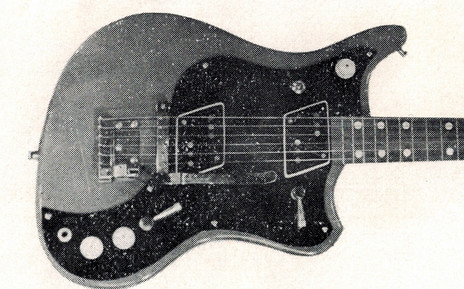
Concord Model 71 guitar, with Novasonic sound, vibrato tailpiece and adjustable bridge. Model 72 included a built-in reverb.
The Esquire six-string released about 1963 included a vibrato tailpiece, an adjustable bridge, twin pickups and a three-position tone lever that produced the Novasonic sound 71. The Esquire was available in sunburst or tomato colours. The model 72 included a flick switch to add built-in reverb and a knob to adjust depth. The matching model 422 bass guitar with a 26 3/4 inch neck featured two pickups and selector switch.
By 1962 Concord had updated the Contessa 7153 to include a sloping control panel and storage compartment. Electric and soprano ukuleles were added, along with two alto and tenor models tuned GDFA. Two more electric guitar designs, the 67 Playboy and the 7/8ths-scale Solomaster, both included a steel truss to prevent warping of the neck. The model H65 steel guitar featured a mahogany and plastic finish. Rock’n’roller Johnny Devlin was reported as ready for another New Zealand tour playing a new Concord G0104 amplifier fitted with twin treble speakers and automatic tremolo.
--
The Concord Collection
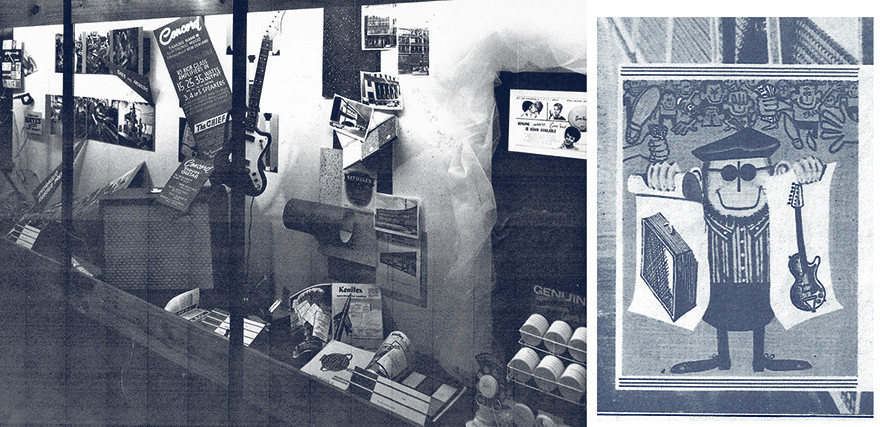
Window display for Concord at Wellington Trade Fair, early 1960s; Concord "Monk" logo. - Gordon Spittle Collection

The Allegro model 350 was among the earliest Concord designs and one of the most popular. Its dual inputs allowed a record player to take one channel, and the other input was used to plug in guitar and strum along.
– Allegro 351. Three tubes. 4.5 watts. Two input channels. Eight-inch dual cone speaker. Described as ideal for students with inputs to plug in record player and guitar and strum along.
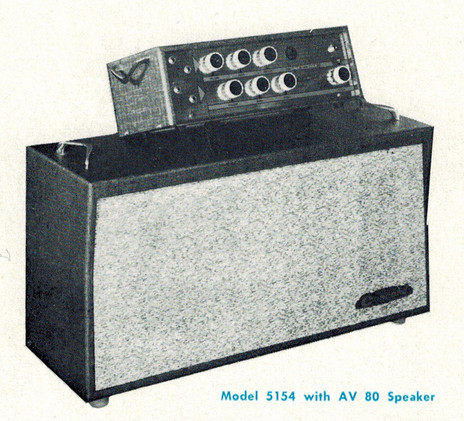
Concord bass amp 5154 and 5304. Concord built two bass rigs, each with a single cabinet which could be pressure loaded with five eight-inch speakers, or a single heavy-duty 12 inch. The 5154 model put out 20 watts power, and 5304 rated 35 watts. The 5304 included extended treble and bass tone controls.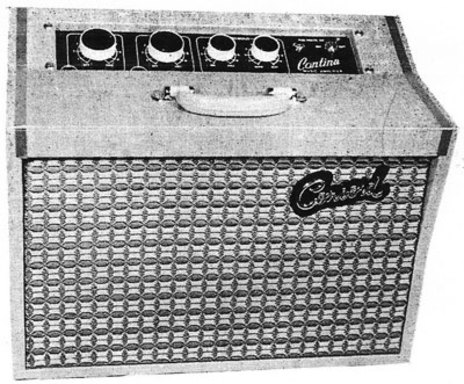
Concord Contina: marked after 1961 as providing independent channels for two instruments with full tremolo, the Contina produced five watts into an eight-inch speaker with tweeter, a big sound "designed for clubs, parties and small halls". Available with beige or oyster heavy vinyl cover. Saron grille and gold trim. - Gordon Spittle Collection
– Contina 463. Four tubes. Five watts. Two inputs. Tremolo. Eight-inch dual cone speaker.
– Contina 463E. Four tubes. Five watts. Two inputs. Released 1960- 1963. Tremolo. 10-inch heavy duty speaker. Designed for “clubs, parties and small halls”.
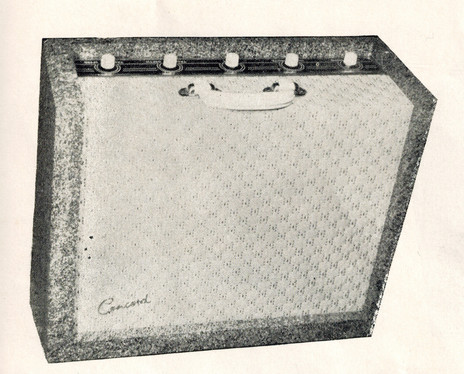
The Conquest guitar amp model 6094 rated 10 watts with six tubes driving two eight-inch heavy duty speakers. Two tremolo inputs with depth and speed controls. Other features include separate power switch, pilot light and non-kink power cable.
– Conquest 6092. Six tubes. 10 watts. Three inputs. Tremolo. 12-inch medium speaker. Described as “plenty of power in small to medium-sized halls and clubs”.
– Contessa 7153. Seven tubes. 15 watts. Two channels with two inputs each. Bass and treble tone controls. Tremolo. Two 12-inch heavy duty speakers.

The Cloud-7 amplifier introduced a clean-cut look on the outside, while a sealed interior compartment for the 12-inch speaker provided a more balanced tone without requiring a larger bulky cabinet. The Cloud-7 rated 25 watts. The Cloud-8 rated 50 watts, driving two 12-inch speakers.
– Statesman 8155 combo. Eight tubes. 15, 25 and 35 watts. Two channels with two inputs each. Bass and treble tone controls. Tremolo.
– Super-Pro 8350 combo. Eight tubes. 15, 25 and 35 watts. Four channels. Bass and treble tone controls.
– Chief 1125 combo. Ten tubes, 25 and 35 watts. Two channels with four inputs each. Reverb.
– Super Chief 1135 combo. Thirteen tubes. Two channels with four inputs each. Bass and treble tone controls. Vibrato and reverb.

The Concord Constellation amp introduced reverb and stereo sound with a smaller seven-watt amplifier placed several feet away supplying a delayed stereo signal. Described as a “professional amplifier which takes recording sessions in its stride”. It featured retractable telescopic adjustable legs and ball-like castors.
– Constellation 9350 combo. Nine valves. Two diodes. Two channels with two inputs each. Separate bass and treble tone controls.
– Custom Constellation 9351. Echomatic 500. Reverb channel with own amplifier and speaker which can be placed away from the main amplifier to provide stereo. Seven-watt amp with six tubes, two inputs and eight- inch speaker.
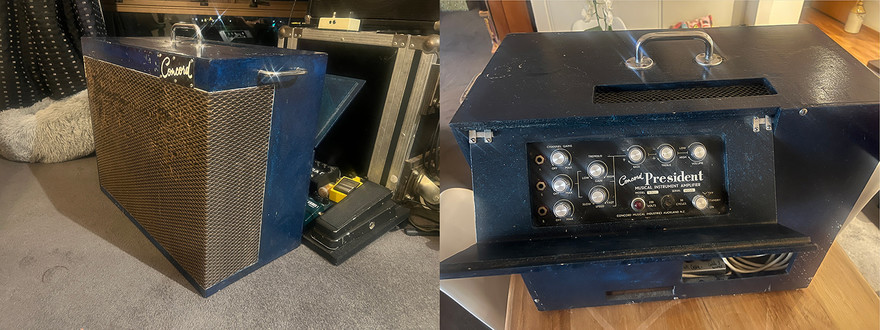
Concord President: three independent inputs, three channel gain controls, tremolo gain and speed controls, treble and bass controls, master volume control, pilot lamp, on/off/standby switch. Model 8170 was rated at 15 watts; model 8300 was 35 watts. - Ian Bates Collection
--
Concord Catalogue, 1960
(For a larger image, right-click on image and open a new tab.)
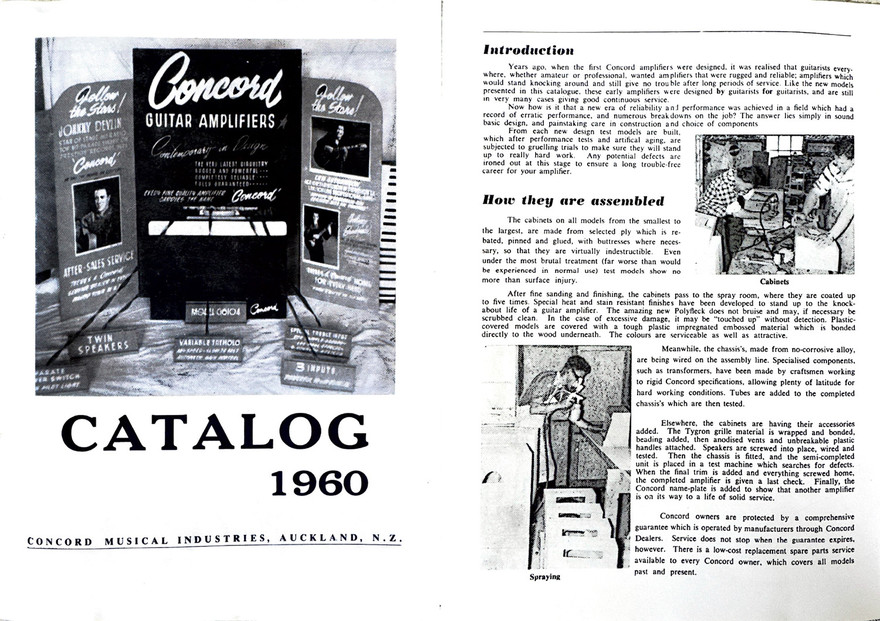
Concord Catalogue 1960. - Clarry Schollum Collection
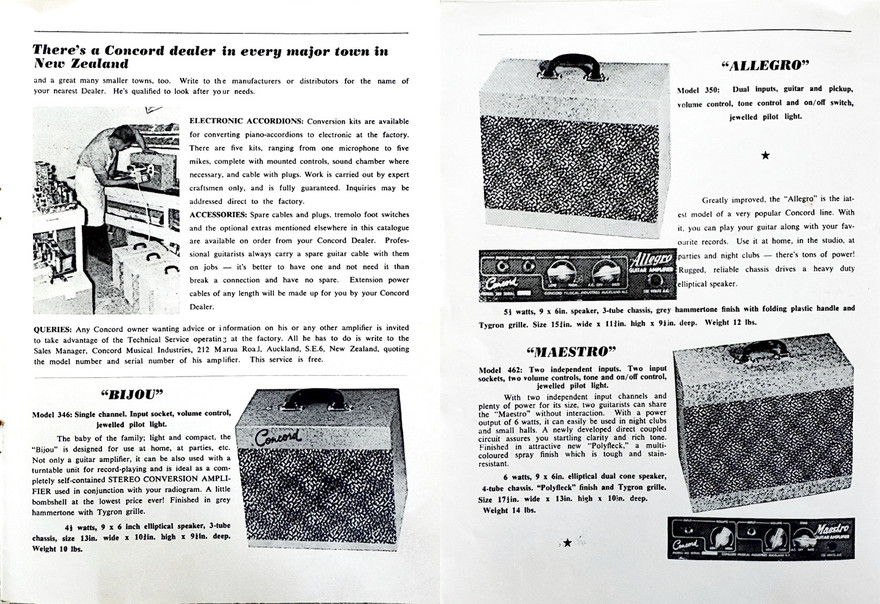
Concord Catalogue 1960: Bijou, Allegro, and Maestro models
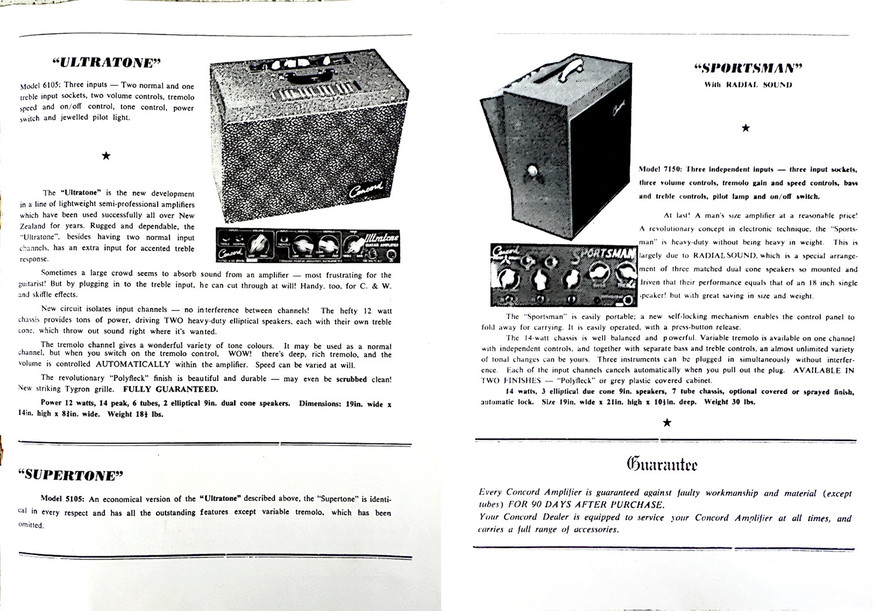
Concord Catalogue 1960: Ultratone, Supertone, and Sportsman models
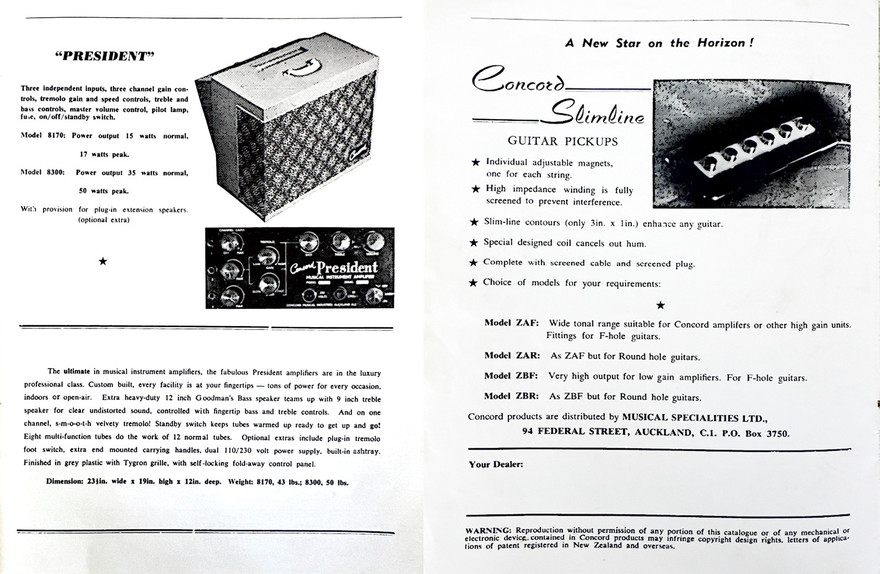
Concord Catalogue 1960: President amplifier and Slimline guitar pickups.
--
Concord Catalogue, 1964

Concord Catalogue 1964. Front and back covers with a miniature Glyn Tucker of the Gremlins pictured on the back. - Clarry Schollum Collection

Concord Catalogue 1964: guitars and the Constellation amplifier
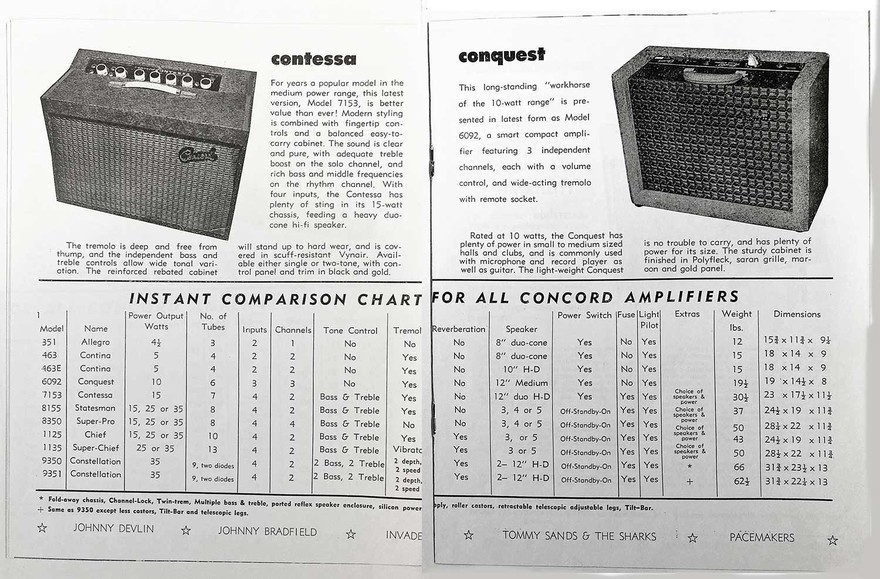
Concord Catalogue 1964: the Contessa and Conquest amplifiers
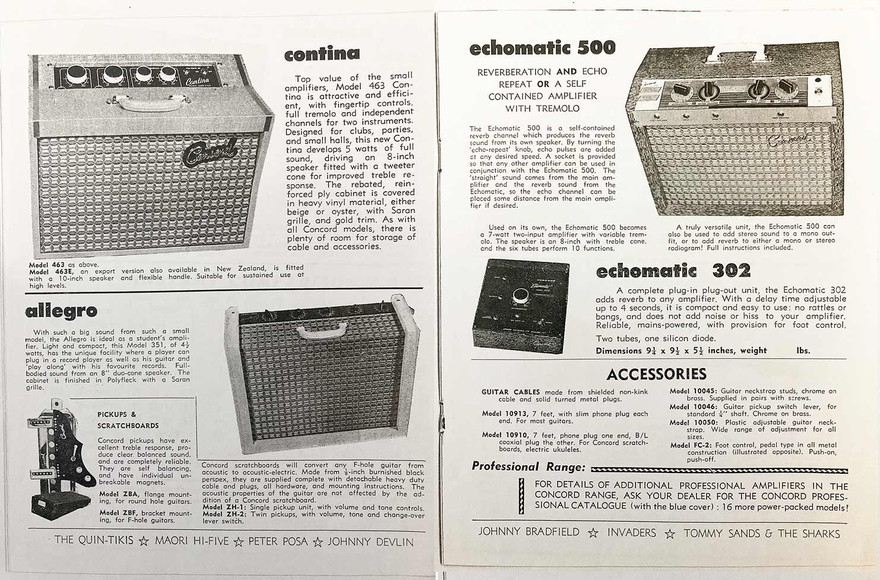
Concord Catalogue 1964: Contina, Allegro, Echomatic amplifier and Echomatic 302 unit.

Concord Catalogue 1964: Echomatic detail and guitar range advertisement.

Concord Catalogue 1964: Chief and Super-Chief models; plus information on Concord guitars and basses
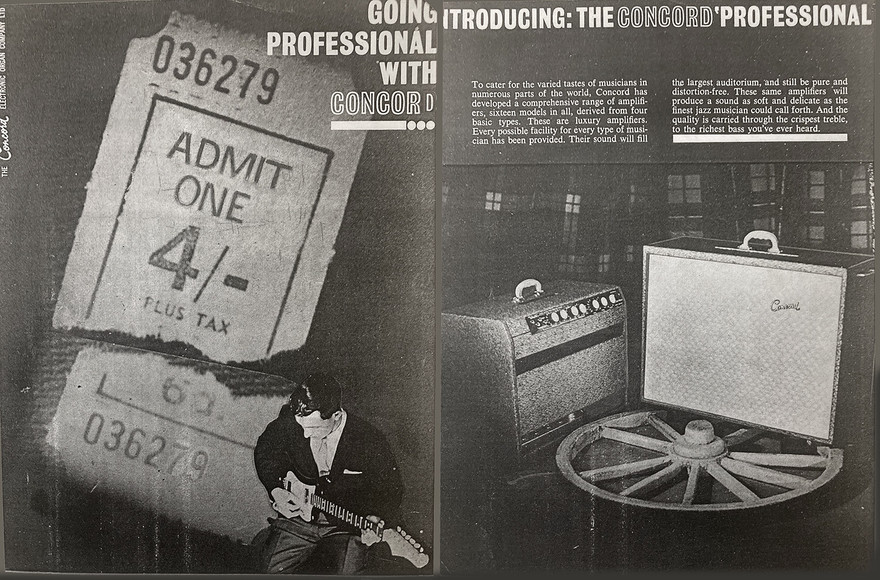
Concord advertisements, 1964.
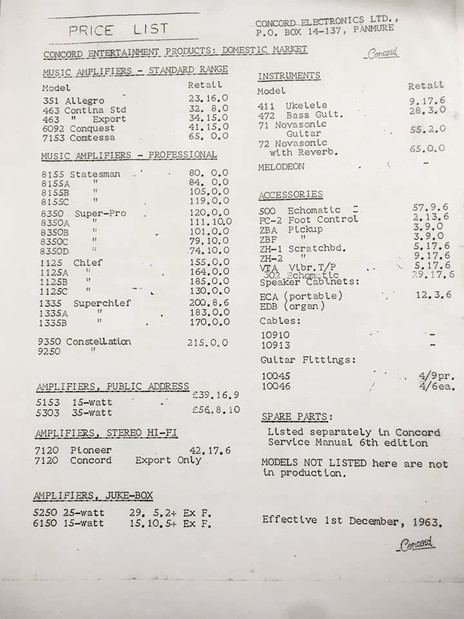
Concord price list, 1963
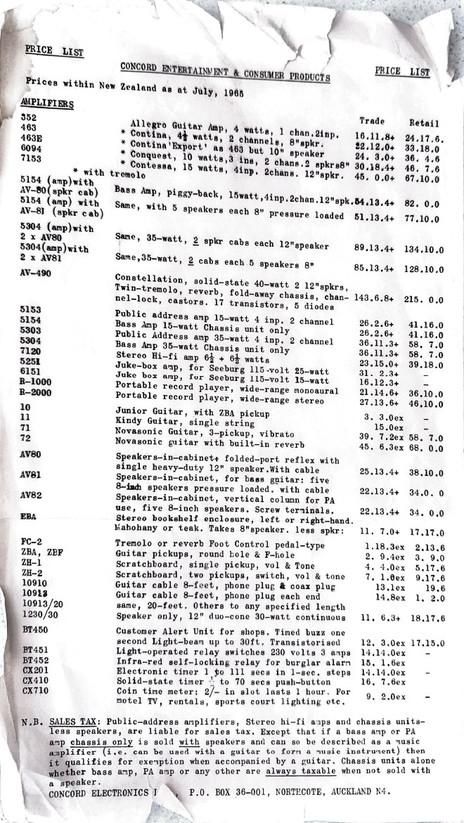
Concord price list, 1965. - Ian Bates Collection
--
Thanks to Bennie Gunn, Clarry Schollum, Paul Kean, Nigel Russell, Ian Bates